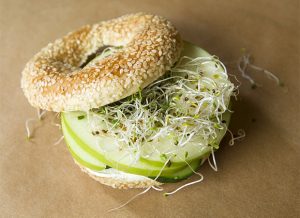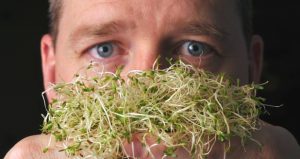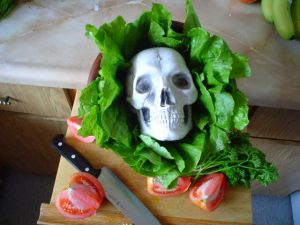Listeria is a nasty bug. With a fatality rate of almost 30 per cent – for those virulent strains – the litanany of outbreaks and its terrible toll are well-known to food safety types.
 But why, despite high standards of cleanliness and hygiene in the food industry, bacteria such as Listeria monocytogenes can still be found in the food processing environment. In a study published in Applied and Environmental Microbiology, a team of researchers from Vetmeduni Vienna has now shown that certain Listeria strains take refuge on an island.
But why, despite high standards of cleanliness and hygiene in the food industry, bacteria such as Listeria monocytogenes can still be found in the food processing environment. In a study published in Applied and Environmental Microbiology, a team of researchers from Vetmeduni Vienna has now shown that certain Listeria strains take refuge on an island.
An “islet” of two genes located in one area of the genome increases the bacteria’s survival under alkaline and oxidative stress conditions. The researchers were able to identify the two genes as a functional unit termed a “stress survival islet”. Understanding this genetic “lifesaver” can help develop new strategies for food safety.
Listeria monocytogenes is a foodborne pathogen that colonizes and reproduces on diverse food products including cheese or meat. Without proper food hygiene, it represents a health risk. The hygiene standards in food production chains, therefore, are quite high. But Listeria is known for its ability to survive in environmental niches in which other microorganisms cannot.
The key to the bacteria’s survival is its adaptability and persistence in stress situations. Certain genetic mechanisms allow L. monocytogenes to react to and block the effects of cleaning solutions and disinfectants. Researchers from the Institute of Milk Hygiene were able to decipher this function for two of the food pathogen’s genes. They showed that these genes form a functional unit that ensures the bacteria’s survival despite the hygiene standards in the food production industry.
Hypervariable, i.e. easily changeable, regions of the genome contain genetic inserts that help Listeria survive. “These inserts include a unit of gene sequences, the stress survival islet 1 (SSI-1), a ‘genomic island’ that helps the microorganisms to survive certain stress situations,” explains first author Eva Harter. “Depending on the specific bacterial strain, this region accommodates one of three different gene sequences whose function, with the exception of SSI-1, had so far not been known.”
The genes in the stress survival islet 1 confer the bacteria a high tolerance toward acidic, bile, salt and gastric stresses and were characterized years ago. This does not explain how the bacteria can survive the hygiene standards in the food processing industry, however, which involves different, namely alkaline and oxidative, stress situations for Listeria. The researchers therefore concentrated on two neighbouring gene sequences within the same hypervariable region and were able to identify these as the genomic islet that acts as a lifesaver for certain Listeria monocytogenes strains in these situations.
The expression of the two genes and of the proteins which they code is increased during alkaline and oxidative stress. They must therefore have a different function than the genes belonging to the SSI-1. “We were able to assign a function to the two genes. The first gene is a transcriptional regulator, which in certain situations regulates the frequency and activity of the second protein. The second is a protease, an enzyme that breaks down other proteins. Proteases help bacteria break down unfunctional proteins that are created during stress situations,” says Harter.
“If the regulator is not active, then there is no protease. Without the protease, Listeria monocytogenes has a harder time compensating oxidative stress. The two genes therefore make up a functional unit, specifically the stress survival islet SSI-2,” says study director Kathrin Rychli. This islet is predominantly found in L. monocytogenes strains that are specialised for food and food processing environments.
“We were able to identify a specific genome type in which the SSI-2 sequence is always present,” explains Rychli. “This sequence type, ST121, is found almost exclusively in food and the food processing environment and hardly ever in clinical isolates. In strains forming part of the ST121 group, SSI-2 is highly conserved i.e. completely identical.” SSI-2 thus appears to be niche-specific. Most Listeria strains found in clinical isolates do not have SSI-2.” Through the discovery of the new stress survival island, the researchers, with project funding provided by the Austrian Science Fund (FWF), were able to describe an important survival strategy of foodborne Listeria. “Knowing the genetic mechanism, allows you to think about new strategies for food safety,” says Rychli.
More information: Eva Harter et al. Stress Survival Islet 2, Predominantly Present in Listeria monocytogenes Strains of Sequence Type 121, Is Involved in the Alkaline and Oxidative Stress Responses, Applied and Environmental Microbiology (2017). DOI: 10.1128/AEM.00827-17
Stress survival islet 2, predominantly present in Listeria monocytogenes strains of sequence type 121, is involved in the alkaline and oxidative stress responses
Appl. Environ. Microbiol. August 2017 vol. 83 no. 16
Eva Harter, Eva Maria Wagner, Andreas Zaiser, Sabrina Halecker, Martin Wagner and Kathrin Rychli
doi: 10.1128/AEM.00827-17
http://aem.asm.org/content/83/16/e00827-17
The foodborne pathogen Listeria monocytogenes is able to survive a variety of stress conditions leading to the colonization of different niches like the food processing environment. This study focuses on the hypervariable genetic hot spot lmo0443 to lmo0449 haboring three inserts: the stress survival islet 1 (SSI-1), the single-gene insert LMOf2365_0481, and two homologous genes of the nonpathogenic species Listeria innocua: lin0464, coding for a putative transcriptional regulator, and lin0465, encoding an intracellular PfpI protease. Our prevalence study revealed a different distribution of the inserts between human and food-associated isolates. The lin0464-lin0465 insert was predominantly found in food-associated strains of sequence type 121 (ST121). Functional characterization of this insert showed that the putative PfpI protease Lin0465 is involved in alkaline and oxidative stress responses but not in acidic, gastric, heat, cold, osmotic, and antibiotic stresses. In parallel, deletion of lin0464 decreased survival under alkaline and oxidative stresses. The expression of both genes increased significantly under oxidative stress conditions independently of the alternative sigma factor σB. Furthermore, we showed that the expression of the protease gene lin0465 is regulated by the transcription factor lin0464 under stress conditions, suggesting that lin0464 and lin0465 form a functional unit. In conclusion, we identified a novel stress survival islet 2 (SSI-2), predominantly present in L. monocytogenes ST121 strains, beneficial for survival under alkaline and oxidative stresses, potentially supporting adaptation and persistence of L. monocytogenes in food processing environments.














